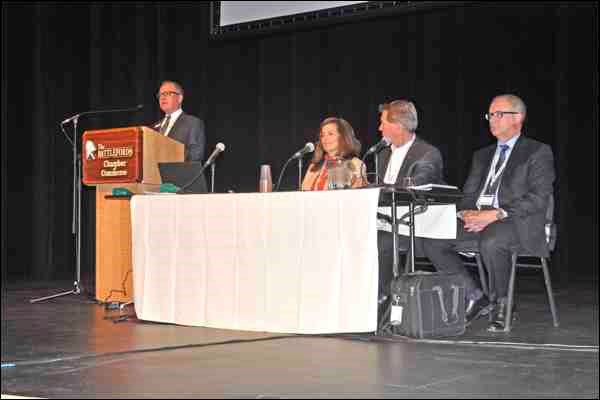The Battlefords were a hub for discussion and information for Saskatchewan agrologists last week.
The Saskatchewan Institute of Agrologists held their 2013 Adaptation Convention featuring "insights for agriculture and the environment," at the Dekker Centre March 19 to 21.
This was an "adaptation convention," as agrologists were looking for answers to the question of how to adapt to changes going on at present and in the future.
Convention attendees had their own "adapting" to do when it came to dealing with the weather conditions. A howling blizzard swept through the Battlefords and the rest of the province Wednesday and Thursday.
That storm shut down a number of area highways, preventing many participants from even making it to the convention and even delaying the departure of attendees Thursday. Attendees were kept informed with updates about weather warnings and road closures throughout the convention.
Despite the poor weather, turnout was good for the three days. The convention was a major undertaking for organizers and proved a good early test of the new Dekker Centre's ability to handle conferences of this magnitude.
Both the main theatre and the rehearsal room were heavily used for convention and dinner activities during the three days.
The first day included presentations from Al Mussell and Wilf Keller titled "Adaptation projections - the Global Picture."
Both spoke of what agriculture will look like 10 years from now. Mussell noted the world will be a "more crowded, hungrier, richer" place, but with "very limited new resources coming in for agriculture resources globally."
He noted agrologists have a role to play in education, research, communicating and guiding "the value of new technology" in the future.
Keller spoke about science and technology and the impact of the biosciences, touching on genomics and genetic-modification. He projected by 2025 a new "golden era" for the agri-food sector, with immense multi-billion Asian markets, leading traceability technology and a sector representing over 30 per cent of the province's GDP
The afternoon session included adaptation projections and the immediate future, with Mary Buhr, consultant Rob Saik and marketing expert Lyndon Carlson.
Buhr, dean of agriculture at the University of Saskatchewan, focused her presentation on food security and agriculture's roles and opportunities. Saik's presentation focused mainly on technology, while Carlson talked about the economic and trade trends, particularly mentioning the growing markets of China and India.
The second day featured discussion of the Saskatchewan Environmental Code and on Value-added Food Opportunities, professional development sessions and concurrent sessions on how producers are adapting to sustainable alternatives.
The third day was impacted significantly by the blizzard conditions and road closures, preventing some guest speakers from attending.
That forced some juggling of the opening segments. The first session dealt with traceability and certification on the farm. A second segment, where Swift Current-based research scientist Chantal Hamel discussed the role of organic production in sustainable agriculture, was initially scheduled to run concurrently as a separate session. Instead, it ran immediately afterwards in the main theatre, replacing a panel discussion that was scuttled due to the poor weather.
In the afternoon the final session discussed leading trends in informational technology with discussion of the impact of social media and Twitter, as well as on useful apps. Kim Keller and Himanshu Singh, both of Farm at Hand Inc., led that discussion.




